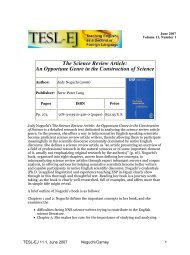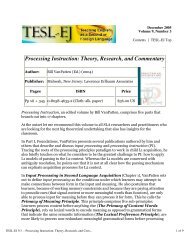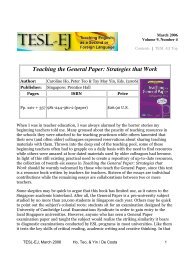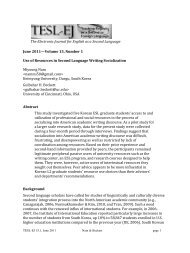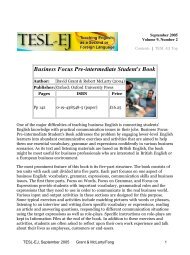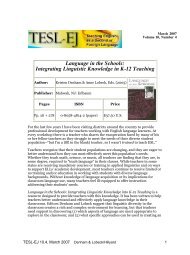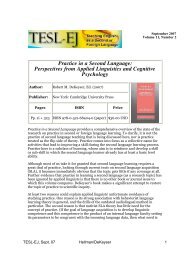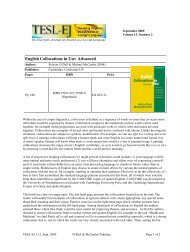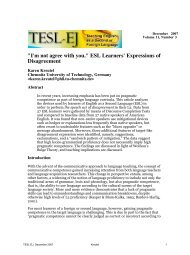TESL-EJ 10.1 -- Tech Talk: Better English through Reading in ...
TESL-EJ 10.1 -- Tech Talk: Better English through Reading in ...
TESL-EJ 10.1 -- Tech Talk: Better English through Reading in ...
You also want an ePaper? Increase the reach of your titles
YUMPU automatically turns print PDFs into web optimized ePapers that Google loves.
June 2006<br />
Volume 10, Number 1<br />
Contents | <strong>TESL</strong>-<strong>EJ</strong> Top<br />
<strong>Tech</strong> <strong>Talk</strong>:<br />
<strong>Better</strong> <strong>English</strong> <strong>through</strong> <strong>Read<strong>in</strong>g</strong> <strong>in</strong> Science and <strong>Tech</strong>nology<br />
Author: Felixa Eskey (2005)<br />
Publisher:<br />
Ann Arbor: University of Michigan Press<br />
Pages ISBN Price<br />
Pp. xiv + 183 0-472-03077-9 (paper)<br />
$24.95 U.S.<br />
(optional compact disk $25.00 U.S.)<br />
Felixa Eskey's <strong>Tech</strong> <strong>Talk</strong>: <strong>Better</strong> <strong>English</strong> <strong>through</strong> <strong>Read<strong>in</strong>g</strong> <strong>in</strong> Science and <strong>Tech</strong>nology is an<br />
assembly of authentic read<strong>in</strong>g texts organized <strong>in</strong>to themed units, along with pre- and postread<strong>in</strong>g<br />
activities for discussion and language practice. An optional 80-m<strong>in</strong>ute audio CD offers<br />
read<strong>in</strong>gs of many of the selections and an answer key for the short-answer exercises <strong>in</strong> the<br />
book can be found onl<strong>in</strong>e by teachers.<br />
The book has n<strong>in</strong>e units: "Computers and Automation", "Flight", "Health Care <strong>in</strong> Space",<br />
"W<strong>in</strong>d Power", "High-<strong>Tech</strong> Lizards", "Time and the Bra<strong>in</strong>", "Eng<strong>in</strong>eer<strong>in</strong>g Achievements",<br />
"Science News and Fun", and "Our Future". Each unit beg<strong>in</strong>s with a Search Your Knowledge<br />
section, which <strong>in</strong>troduces the topic <strong>through</strong> questions or short activities. Some chapters also<br />
have a "Key Words" section, based on the chapter read<strong>in</strong>g's vocabulary, which <strong>in</strong>troduces key<br />
words and phrases <strong>through</strong> sample sentences. After these pre-read<strong>in</strong>g exercises comes the<br />
read<strong>in</strong>g. Some units have just one read<strong>in</strong>g selection (e.g., "Health Care <strong>in</strong> Space") while others<br />
have as many as four (e.g., "Science News and Fun"), for a total of sixteen read<strong>in</strong>gs <strong>in</strong> the book.<br />
<strong>Read<strong>in</strong>g</strong>s range <strong>in</strong> length from half a page to about ten pages, and most read<strong>in</strong>gs <strong>in</strong>tegrate<br />
graphs, charts, draw<strong>in</strong>gs or visuals of some sort. Key vocabulary terms are underl<strong>in</strong>ed, and<br />
selected technical terms, idioms, and other words are def<strong>in</strong>ed <strong>in</strong> the right marg<strong>in</strong> of the<br />
read<strong>in</strong>g.<br />
<strong>Read<strong>in</strong>g</strong>s are followed by a series of five post-read<strong>in</strong>g activities:<br />
What's the Po<strong>in</strong>t? - read<strong>in</strong>g comprehension questions <strong>in</strong> a variety of forms: multiple<br />
choice, short answer, true and false, or sentence completion.<br />
Understand<strong>in</strong>g Words and Phrases - vocabulary exercises such as fill <strong>in</strong> the blank,<br />
multiple choice, or short answer questions.<br />
Grammar Check - one grammar po<strong>in</strong>t exemplified <strong>in</strong> the read<strong>in</strong>g. Examples <strong>in</strong>clude the<br />
<strong>TESL</strong>-<strong>EJ</strong> <strong>10.1</strong>, June 2006 Eskey/Carney 1
passive, adverb phrases, and quoted and reported speech.<br />
Let's <strong>Talk</strong> about It - discussion questions<br />
What Do You Th<strong>in</strong>k? - a writ<strong>in</strong>g prompt<br />
Expansion Activity (every unit except 1, 2 and 4) - outside-class <strong>in</strong>vestigations such as the<br />
one <strong>in</strong> "Time and the Bra<strong>in</strong>" to try to replicate an experiment mentioned <strong>in</strong> the read<strong>in</strong>g<br />
(p. 103), or the suggestion <strong>in</strong> other units to search the Internet for <strong>in</strong>formation related to<br />
the read<strong>in</strong>g.<br />
A major question for me as I reviewed Eskey's book was, "Would this book be good for my<br />
students?" In her <strong>in</strong>troduction, Eskey writes that "This textbook is appropriate for all adults. It<br />
would be particularly useful to <strong>English</strong> students who are also scientists and eng<strong>in</strong>eers,<br />
<strong>in</strong>clud<strong>in</strong>g university students and professionals" (p. x). I teach undergraduate science and<br />
technology students at a large university <strong>in</strong> Japan. Current materials I use for teach<strong>in</strong>g read<strong>in</strong>g<br />
somewhat resemble the composition of Eskey's textbook: authentic science and technologythemed<br />
read<strong>in</strong>gs with pre- and post-read<strong>in</strong>g activities for <strong>English</strong> language development.<br />
Beyond this model, a clear strength of Eskey's text is the logical and consistent organization of<br />
activities with<strong>in</strong> each chapter, and the attempt to satisfy learn<strong>in</strong>g the four skills (i.e., Grammar,<br />
Listen<strong>in</strong>g, <strong>Read<strong>in</strong>g</strong>, and Writ<strong>in</strong>g) by <strong>in</strong>clud<strong>in</strong>g diverse language activities related to the read<strong>in</strong>g.<br />
Teachers will f<strong>in</strong>d this book very easy to use, and EFL teachers without a strong science<br />
background will not have trouble comprehend<strong>in</strong>g the science talked about <strong>in</strong> the book (nor<br />
should students). Because of the considerable number of activities for each read<strong>in</strong>g and the<br />
book's n<strong>in</strong>e autonomous units, <strong>Tech</strong> <strong>Talk</strong> also lends itself to a flexible syllabus. In other words,<br />
skipp<strong>in</strong>g chapters or activities would not deprive students of knowledge found <strong>in</strong> later<br />
chapters. It should be noted, however, that the difficulty level of read<strong>in</strong>gs does <strong>in</strong>crease<br />
somewhat as the book progresses.<br />
Yet despite the appeal of such convenience and flexibility <strong>in</strong> us<strong>in</strong>g Eskey's book, for my own<br />
students I would have questions about both the value of the read<strong>in</strong>gs and the degree of<br />
progress my EFL science and technology students would make by work<strong>in</strong>g <strong>through</strong> the text.<br />
Aside from difficulty level and an overall science and technology theme, there are no clear<br />
criteria for the selection of read<strong>in</strong>gs <strong>in</strong>cluded or for the themes of the different units. Also<br />
weaknesses are the lack of <strong>in</strong>tegration among different units and the lack of a def<strong>in</strong><strong>in</strong>g,<br />
centraliz<strong>in</strong>g theme any more specific than science and technology. Such deficits make one<br />
wonder if students would have any opportunity to review and reuse either the vocabulary or<br />
the knowledge they are exposed to over the course of read<strong>in</strong>g the text. There is no obvious<br />
repetition of vocabulary <strong>through</strong>out the units, and there is no discussion of writ<strong>in</strong>g structure<br />
(e.g., <strong>in</strong>troduction, thesis, topic sentences). Likewise, there is no mention of how to read <strong>in</strong> the<br />
sciences. The one page preface addressed to students entitled "How to Read" (p. xiii) is rather<br />
general <strong>in</strong> scheme, with advice such as, "For a longer text, you may want to skim it first" (p.<br />
xiii), or "Read quickly, but comfortably" (p. xiii). In addition, nowhere <strong>in</strong> the book is genre, a<br />
key concept <strong>in</strong> read<strong>in</strong>g science, mentioned. A basic question about this book for any teacher<br />
might be whether, taken as a whole, it offers her more than she already has.<br />
Two key th<strong>in</strong>gs I was look<strong>in</strong>g for <strong>in</strong> <strong>Tech</strong> <strong>Talk</strong> were (1) an academic approach to scientific<br />
read<strong>in</strong>g, and (2) supplementary materials (beyond the functional exercises provided) to<br />
enhance the science and technology theme:<br />
(1) The <strong>in</strong>clusion of more technically demand<strong>in</strong>g read<strong>in</strong>g for student analysis and a<br />
<strong>TESL</strong>-<strong>EJ</strong> <strong>10.1</strong>, June 2006 Eskey/Carney 2
discussion of the different genres with<strong>in</strong> the wide range of science writ<strong>in</strong>g. My own<br />
students, as undergraduates, are already try<strong>in</strong>g to tackle the <strong>English</strong> of scientific<br />
academic journals. All the read<strong>in</strong>gs <strong>in</strong> <strong>Tech</strong> <strong>Talk</strong> fall with<strong>in</strong> the genre popular<br />
science news, decidedly different from academic journal writ<strong>in</strong>g. Contrast<strong>in</strong>g how<br />
to read an article from a popular-science news source and a journal article would<br />
be very valuable. Short of this, a discussion of the structures of the popular science<br />
articles <strong>in</strong> the book would be useful.<br />
(2) A more robust collection of supplementary materials is needed. The optional<br />
audio CD is f<strong>in</strong>e for listen<strong>in</strong>g to a science news story, but especially when deal<strong>in</strong>g<br />
with science and technology it would seem that hav<strong>in</strong>g video clip visuals, or at least<br />
pictures, along with a virtual version of the textbook <strong>in</strong>clud<strong>in</strong>g Internet l<strong>in</strong>ks would<br />
be very useful for students. The classrooms at our university are all equipped with<br />
computer projectors, and many rooms have computers for students' use, so it would<br />
not be unreasonable, at least <strong>in</strong> our circumstance, to be read<strong>in</strong>g and follow<strong>in</strong>g l<strong>in</strong>ks<br />
and <strong>in</strong>tegrat<strong>in</strong>g multimedia materials to develop our students' read<strong>in</strong>g skills and<br />
<strong>in</strong>terests. For a teach<strong>in</strong>g situation absent such technology at hand, <strong>Tech</strong> <strong>Talk</strong> would<br />
suffice. But <strong>in</strong>clud<strong>in</strong>g an activity-filled CD-ROM would still seem desirable for a<br />
technology-themed textbook published <strong>in</strong> 2005.<br />
EFL/ESL teachers will f<strong>in</strong>d <strong>Tech</strong> <strong>Talk</strong> a convenient compilation of science and technology<br />
journalism accompanied by plentiful <strong>English</strong> language learn<strong>in</strong>g activities geared toward<br />
<strong>in</strong>termediate and higher level students. For teachers <strong>in</strong> Intensive <strong>English</strong> programs, high<br />
schools, or other teach<strong>in</strong>g situations where science and technology are not the ma<strong>in</strong> class<br />
focus, Eskey's book can be a perfect fit for delv<strong>in</strong>g <strong>in</strong>to some modern, fasc<strong>in</strong>at<strong>in</strong>g scientific<br />
topics over the course of a term. On the other hand, teachers look<strong>in</strong>g for a textbook that<br />
teaches students how to beg<strong>in</strong> to ga<strong>in</strong> command of comprehend<strong>in</strong>g academic science writ<strong>in</strong>g,<br />
this book will fall short. Likewise, teachers who want a science and technology text that<br />
<strong>in</strong>tegrates current technology may not be satisfied with this book and audio CD alone. In any<br />
case, it is a pleasure to see-with<strong>in</strong> this t<strong>in</strong>y category of ESL/EFL textbooks-another science and<br />
technology book. For that reason alone, <strong>Tech</strong> <strong>Talk</strong> is surely worth a look.<br />
Nathaniel Carney<br />
Kwansei Gaku<strong>in</strong> University, Japan<br />
<br />
© Copyright rests with authors. Please cite <strong>TESL</strong>-<strong>EJ</strong> appropriately.<br />
Editor's Note: The HTML version conta<strong>in</strong>s no page numbers. Please use the PDF<br />
version of this article for citations.<br />
<strong>TESL</strong>-<strong>EJ</strong> <strong>10.1</strong>, June 2006 Eskey/Carney 3



